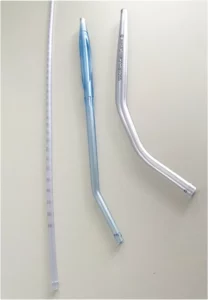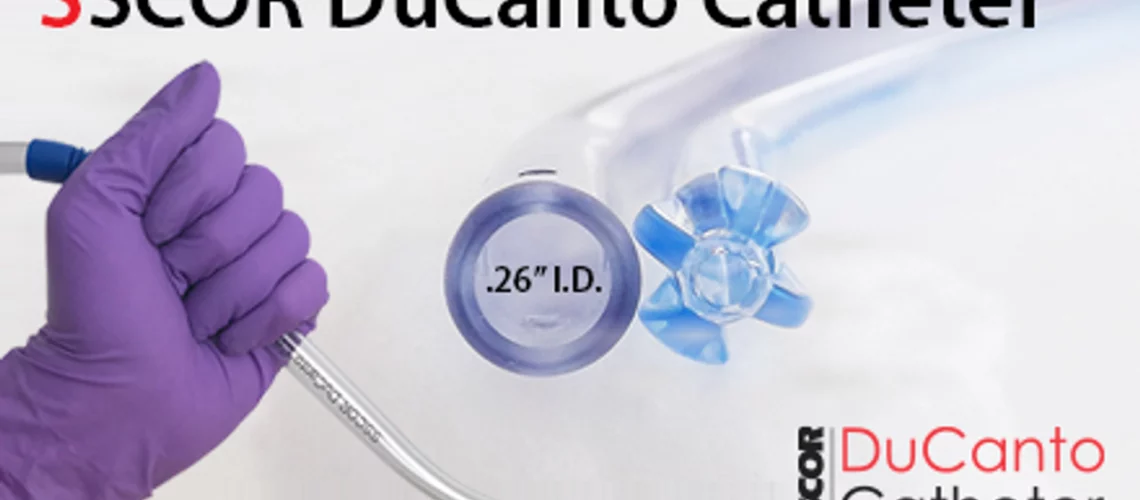Airway aspiration is a crucial skill in emergency medicine. Whether during a difficult intubation, facing a regurgitating patient, or in case of upper airway hemorrhage, the ability to quickly and effectively clear the airway can make the difference between life and death. However, not all suction devices are created equal. A recent study by Finke et al. published in BMC Anesthesiology in 2022 provides interesting insights into the comparative performance of different suction catheters [1].
Context and Issues
Pulmonary aspiration remains a dreaded complication in airway management, potentially leading to significant morbidity and mortality [2]. Despite advances in anesthesia and resuscitation techniques, the risk persists. A recent review of 166,491 anesthesia records revealed 20 cases of pulmonary aspiration and 20 additional cases of regurgitation without aspiration [3]. These figures, although relatively low, underscore the importance of being prepared to effectively manage this complication.
The consequences of aspiration can range from aspiration pneumonia to severe acute respiratory distress syndrome, dubbed “Mendelson syndrome” after the physician who first described it in 1946 [4]. The severity depends on several factors, including the volume and nature of the aspirated content, as well as the speed of management.
In this context, having a high-performance suction device is essential. However, suction performance can vary considerably depending on the catheters used, particularly when facing liquids of varying viscosity.
The Finke et al. Study
The objective of this study was to compare the suction rates of three types of catheters: 
– A standard 14 Ch suction catheter (SC)
– A Yankauer catheter (Y)
– A new DuCanto catheter (DC)
These catheters were tested with 4 fluids of different viscosity:
– Tap water (lowest viscosity)
– Syrup-like consistency (10 g of thickener per liter of water)
– Honey-like consistency (20 g/L)
– Pudding-like consistency (30 g/L)
Experimental protocol:
– Each preparation was suctioned for 15 seconds with the three devices
– Measurements were repeated four times
– The amount of liquid suctioned was measured using a tared scale
Main results:
-
- For water:

- For water:
– SC: 580 ± 34 mg
– Y: 888 ± 5 mg
– DC: 1087 ± 15 mg
-
- Syrup-like viscosity:
– SC: 383 ± 34 mg
– Y: 661 ± 64 mg
– DC: 935 ± 42 mg
-
- Honey-like viscosity:
– SC: 191 ± 21 mg
– Y: 426 ± 34 mg
– DC: 590 ± 68 mg
-
- Pudding-like viscosity:
– SC: 74 ± 13 mg
– Y: 164 ± 6 mg
– DC: 211 ± 8 mg
These results clearly show that the new DuCanto catheter was more effective than the Yankauer catheter, which was more effective than the standard suction catheter, for all viscosities tested. The relative superiority of the DuCanto was more pronounced as the viscosity of the fluid increased.
Practical Implications
These results have important implications for clinical practice in emergency medicine:
-
- Effectiveness against viscous fluids:
The DuCanto catheter proved particularly effective in suctioning high-viscosity fluids. This can be crucial when managing gastric content regurgitation or upper airway hemorrhage, where blood can quickly coagulate.
-
- Speed of action:
With a standard catheter, suctioning 250 mL of pudding-like fluid would take nearly a minute. The DuCanto catheter would reduce this time to about 17.5 seconds. In an emergency situation, where every second counts, this difference can be decisive.
-
- Prevention of massive aspiration:
The longer the suction time, the higher the risk of massive aspiration. A more efficient catheter could therefore help reduce the incidence and severity of Mendelson syndromes.
-
- Adaptability:
The superiority of the DuCanto catheter is maintained regardless of fluid viscosity. This makes it a versatile tool, suitable for various clinical situations.
Limitations and Perspectives
Although this study provides valuable information, it has certain limitations:
-
- Simulation model:
Like any bench study, it cannot perfectly reproduce the real conditions of an emergency situation. However, given the ethical and practical difficulty of conducting prospective controlled studies on aspiration, this type of model remains a valid method for evaluating the performance of suction devices.
-
- Absence of particulate elements:
The study did not use real gastric contents, which could contain solid particles capable of obstructing catheters. Actual performance in clinical situations could therefore be lower than observed in this study.
-
- Lack of testing in intubation situations:
The study did not evaluate these catheters in an intubation scenario, which could highlight other advantages or disadvantages of the different devices.
Despite these limitations, this study provides objective data on the relative performance of different suction catheters, valuable information to guide equipment choice in emergency medicine.
Broader Context
To fully understand the importance of these results, it is useful to place them in the broader context of emergency airway management.
-
- Evolution of recommendations:
The latest American Society of Anesthesiologists (ASA) guidelines on difficult airway management, published in 2022, emphasize the importance of having suction equipment immediately available [5]. These results could influence future recommendations in favor of large-diameter catheters like the DuCanto.
-
- Rapid Sequence Induction (RSI):
RSI is the technique of choice for intubating patients at risk of aspiration [6]. A high-performance suction device is a key element of safety during this procedure.
-
- Out-of-operating room intubation:
Intubations performed in emergency departments, intensive care units, or pre-hospital settings are associated with a higher risk of complications [7]. In these contexts, the availability of an effective suction catheter could improve procedure safety.
-
- Training and simulation:
These results underscore the importance of including the handling of different types of suction catheters in airway management training and simulations.
Improvement Perspectives
Although the DuCanto catheter seems to offer significant advantages, it is important to continue seeking ways to improve airway suction. Here are some areas to explore:
-
- Ergonomic design:
Beyond catheter diameter, device ergonomics can influence its effectiveness in real situations. Studies on usability under stress conditions could provide valuable information.
-
- Innovative materials:
The development of materials with anti-adhesive properties could improve suction efficiency, particularly for viscous fluids.
-
- Filtration systems:
Integrating filtration systems could allow more effective management of fluids containing solid particles while maintaining high suction flow.
-
- Multifunctional devices:
Devices combining suction and visualization (like some video laryngoscopes) could further improve difficult airway management.
-
- Continuous suction:
Systems allowing continuous suction during intubation, without hindering visualization, could represent a significant advance.
Practical Considerations for Emergency Physicians
As an emergency physician, how can you integrate this information into your daily practice?
-
- Equipment evaluation:
Examine the suction catheters available in your department. If you primarily use standard or Yankauer catheters, consider introducing larger diameter catheters like the DuCanto.
-
- Airway management protocols:
Explicitly integrate the choice of suction catheter into your protocols for managing difficult or aspiration-risk airways.
-
- Team training:
Ensure that the entire team is trained in using the different types of catheters available. Organize simulation sessions including suction scenarios with different fluid viscosities.
-
- Anticipatory preparation:
For high-risk patients (morbid obesity, hiatal hernia, severe gastroesophageal reflux, etc.), prepare the most effective catheter in advance.
-
- Post-intervention debriefing:
After each use of a suction catheter in a critical situation, discuss its effectiveness and any difficulties encountered as a team.
-
- Technology watch:
Stay informed about the latest advances in suction devices. Innovation in this field could bring significant improvements to your practice.
Conclusion
The Finke et al. study provides objective data on the comparative performance of different suction catheters. It highlights the superiority of large-diameter catheters, particularly the new DuCanto catheter, for suctioning fluids of varying viscosity.
These results have important implications for emergency medicine practice. They underscore the importance of choosing the right suction catheter, especially in high-risk situations for aspiration or regurgitation. The ability to quickly and effectively clear the airway can make the difference between successful management and serious complications.
However, it is important to keep in mind that catheter choice is just one element of a comprehensive airway management strategy. Careful patient assessment, adequate preparation, appropriate intubation technique, and close monitoring remain essential.
As emergency physicians, we must constantly seek to improve our practices to offer the best possible care to our patients. Integrating more effective suction catheters into our therapeutic arsenal is a step in this direction. But it is our vigilance, experience, and ability to adapt quickly that will always remain our best assets in facing the challenges of emergency medicine.
References:
[1] Finke S-R, Schroeder DC, Ecker H, Böttiger BW, Herff H, Wetsch WA. Comparing suction rates of novel DuCanto catheter against Yankauer and standard suction catheter using liquids of different viscosity—a technical simulation. BMC Anesthesiol. 2022;22(1):285.
[2] Apfelbaum JL, Hagberg CA, Connis RT, et al. 2022 American Society of Anesthesiologists Practice Guidelines for Management of the Difficult Airway. Anesthesiology. 2022;136(1):31-81.
[3] Sun J, Wei G, Hu L, Liu C, Ding G. Perioperative pulmonary aspiration and regurgitation without aspiration in adults: a retrospective observational study of 166,491 anesthesia records. Ann Palliat Med. 2021;10(4):4037-4046.
[4] Mendelson CL. The aspiration of stomach contents into the lungs during obstetric anesthesia. Am J Obstet Gynecol. 1946;52:191-205.
[5] Apfelbaum JL, Hagberg CA, Connis RT, et al. 2022 American Society of Anesthesiologists Practice Guidelines for Management of the Difficult Airway. Anesthesiology. 2022;136(1):31-81.
[6] Wetsch WA, Hinkelbein J. Current national recommendations on rapid sequence induction in Europe. How standardised is the “standard of care”? Eur J Anaesthesiol. 2014;31(8):443-444.
[7] Higgs A, McGrath BA, Goddard C, et al. Guidelines for the management of tracheal intubation in critically ill adults. Br J Anaesth. 2018;120(2):323-352.
